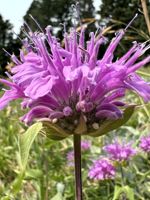Mon-Fri 9am - 5pm Mountain time
Wild Bergamot vs Showy Aster
Monarda fistulosa
Eurybia conspicua
NOT AVAILABLE THIS SEASON - MIGHT RETURN
CUSTOM GROW
Wild Bergamot is a native perennial wildflower that is known for its fragrant lilac-purple tubular flowers. The flowers grow in dense terminal heads and bloom from mid-summer to early fall. Deadheading spent flowers will encourage new blooms, prolonging its display. They attract pollinators such as bees, butterflies, and hummingbirds. It also serves as a host plant for the Raspberry Pyrausta (Pyrausta signatalis) butterfly.
Wild Bergamot belongs to the mint family, and its leaves, stems, and flowers are all edible. The leaves can be used to make tea or as a flavorful herb, with a taste often described as a blend of oregano and thyme.
It is resistant to deer and rabbits but can be susceptible to powdery mildew if planted too densely with poor air circulation. Wild Bergamot tolerates heat, drought, and poor soils, making it a low-maintenance addition to a variety of projects. It is well suited for pollinator gardens, wildflower gardens and naturalization projects.
Showy Aster is a native perennial wildflower recognized for its tall stems topped with clusters of light purple blooms. Blooming from late summer into autumn, it provides an important late-season source of nectar and pollen for pollinators. It also produces seeds that are eaten by birds, extending its value to wildlife beyond the flowering season.
Drought tolerant once established, Showy Aster grows well in urban, rural, and disturbed sites. With its mix of ecological value and ornamental appeal, it is ideal for pollinator gardens, naturalization projects, and ecological restoration.

